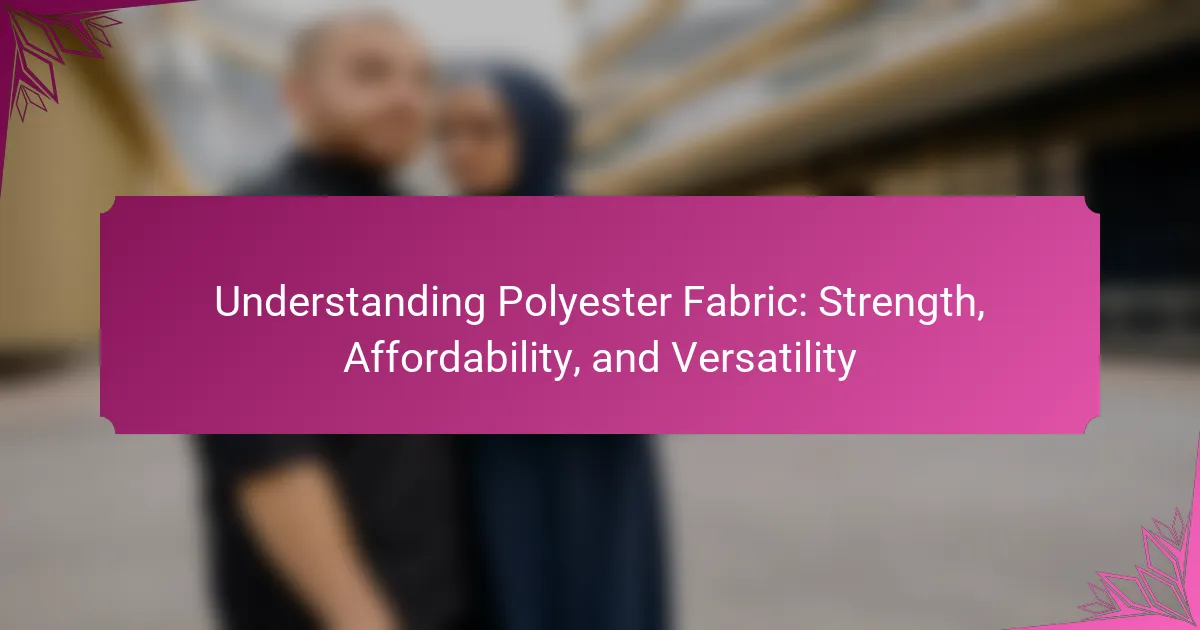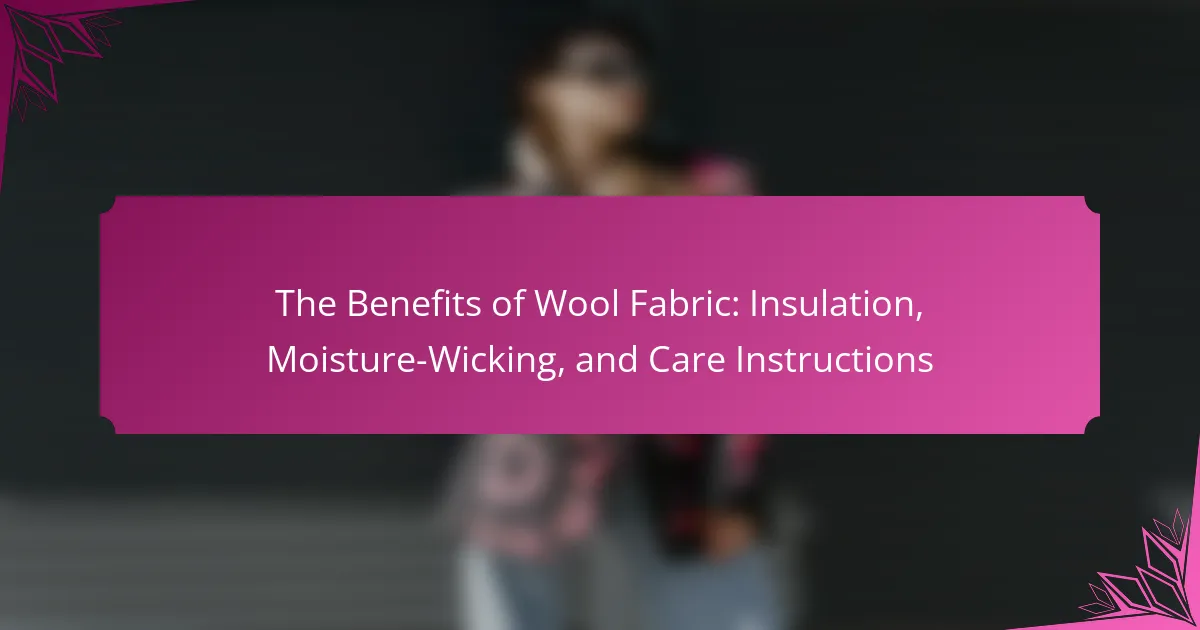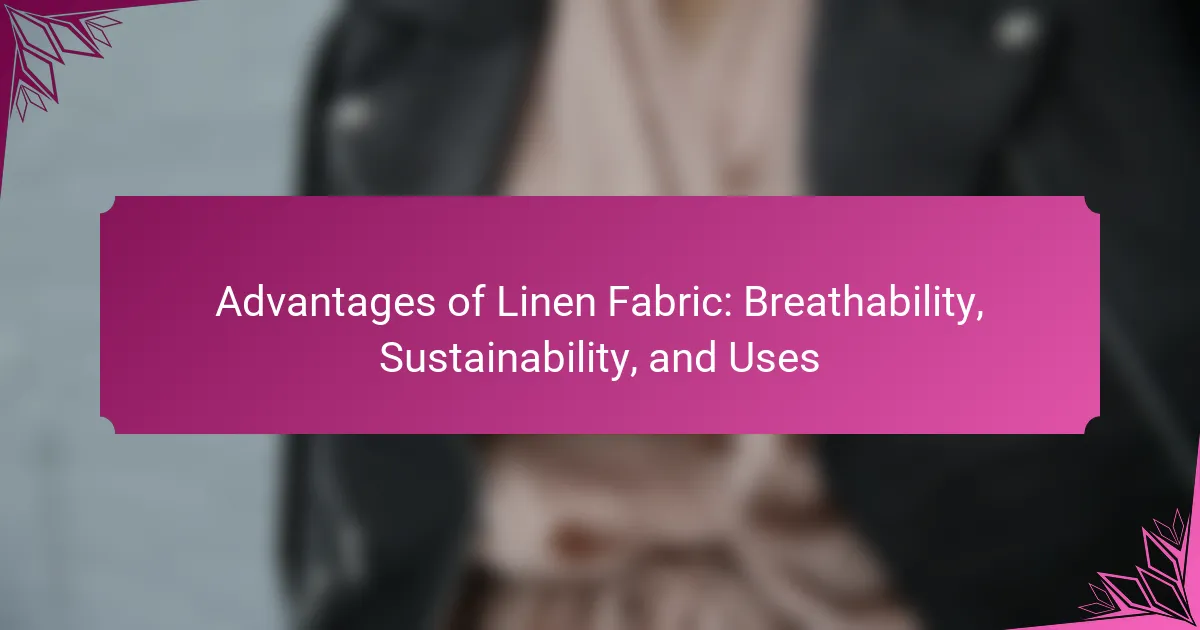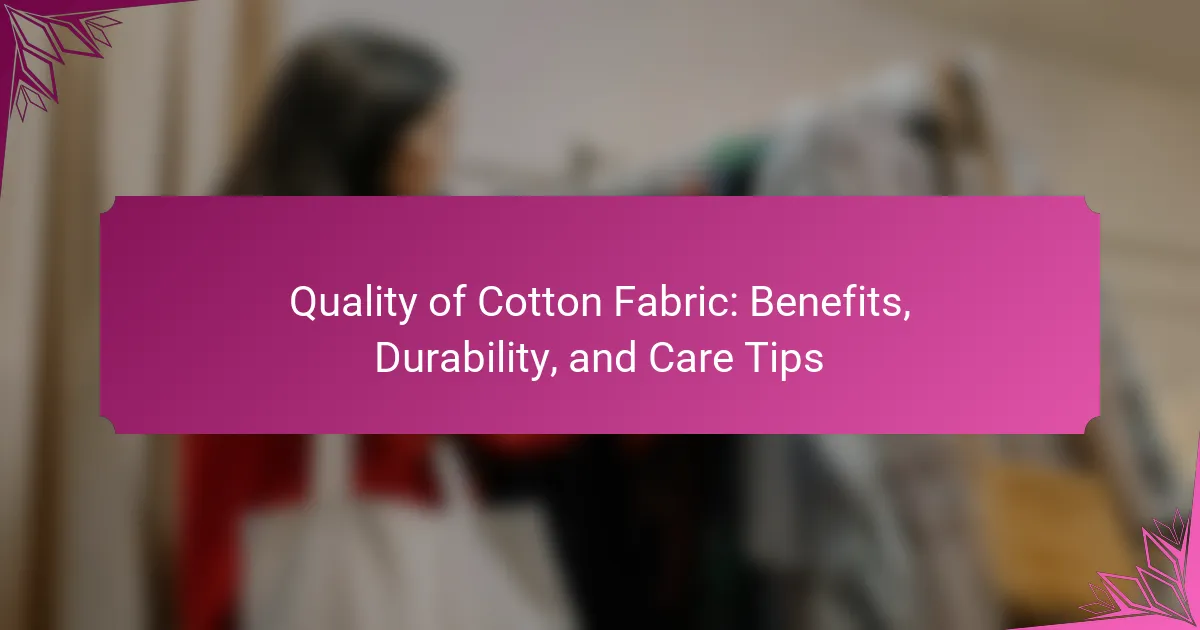Rayon fabric is a semi-synthetic textile created from regenerated cellulose fibers derived from natural sources like wood pulp. This article analyzes the characteristics of rayon, highlighting its comfort, soft texture, excellent drape, and breathability, making it ideal for clothing and home textiles, particularly in warm weather. The discussion includes best practices for maintaining rayon, such as washing in cold water, air-drying, and proper storage techniques to extend its lifespan. Additionally, the article addresses the environmental considerations associated with rayon production, providing a comprehensive understanding of its applications and care.

What is Rayon Fabric?
Rayon fabric is a semi-synthetic textile made from regenerated cellulose fibers. It is derived from natural sources such as wood pulp. The production process involves dissolving cellulose and then regenerating it into fibers. Rayon is known for its soft texture and excellent drape. It is often used in clothing, upholstery, and various textile applications. This fabric is breathable and comfortable against the skin. Rayon can mimic the feel of silk, wool, or cotton, making it versatile. Its moisture-absorbing properties enhance its wearability in warm weather.
How is Rayon Fabric made?
Rayon fabric is made from regenerated cellulose fibers. The process begins with dissolving wood pulp in a chemical solution. This solution is then extruded through spinnerets to form filaments. The filaments are solidified in a coagulating bath. Afterward, the filaments are washed and dried. The resulting fibers are then spun into yarn. Finally, the yarn is woven or knitted to create rayon fabric. This method utilizes natural materials, primarily sourced from trees.
What are the raw materials used in Rayon Fabric production?
The raw materials used in Rayon fabric production primarily include cellulose, which is derived from wood pulp. This cellulose is chemically processed to create regenerated cellulose fibers. Common sources of cellulose for Rayon include trees like beech, pine, and eucalyptus. The production process involves dissolving the cellulose in a solvent, typically sodium hydroxide, to form a viscous solution. This solution is then extruded through spinnerets to form fibers. These fibers are subsequently regenerated through a series of chemical treatments. The reliance on natural cellulose sources underscores Rayon’s classification as a semi-synthetic fiber.
What processes are involved in transforming raw materials into Rayon Fabric?
The processes involved in transforming raw materials into Rayon Fabric include several key steps. First, cellulose is extracted from wood pulp or cotton linters. Next, the cellulose is dissolved in a chemical solution, typically sodium hydroxide. This creates a viscous solution known as viscose. The viscose is then extruded through spinnerets to form filaments. After spinning, the filaments are regenerated by passing them through a coagulation bath. This process solidifies the filaments into Rayon fibers. Finally, the fibers are washed, dried, and cut to the desired length for fabric production. Each of these steps is essential for producing high-quality Rayon Fabric.
What are the key characteristics of Rayon Fabric?
Rayon fabric is known for its softness and comfort. It has a smooth texture that feels good against the skin. Rayon is highly absorbent, making it suitable for warm weather. It drapes well, giving garments a flattering silhouette. The fabric can mimic the appearance of silk, wool, or cotton. Rayon is also breathable, enhancing wearability in various climates. However, it can wrinkle easily and may require special care when washing. Its production involves cellulose from wood pulp, raising environmental considerations regarding sustainability.
How does Rayon Fabric compare to other fabrics in terms of comfort?
Rayon fabric is generally considered more comfortable than many other fabrics. It has a soft, smooth texture that feels pleasant against the skin. Rayon is highly breathable, allowing for good air circulation. This makes it suitable for warm weather, as it helps to keep the body cool. Additionally, rayon has excellent moisture-wicking properties, which can enhance comfort during physical activity. Unlike some synthetic fabrics, rayon does not cling to the body, reducing irritation. Compared to cotton, rayon can provide a silk-like feel, adding to its comfort appeal. Overall, rayon’s combination of softness, breathability, and moisture management contributes to its reputation for comfort in textiles.
What draping qualities make Rayon Fabric unique?
Rayon fabric is unique due to its excellent draping qualities. It has a smooth texture that allows it to flow gracefully. This fabric drapes well, creating elegant silhouettes in garments. Rayon has a soft hand feel, enhancing comfort against the skin. It mimics the drape of silk, giving it a luxurious appearance. Additionally, rayon’s weight contributes to its ability to hang beautifully. This fabric also retains its shape well, making it ideal for various styles. Its versatility makes rayon a popular choice in fashion design.
What are the environmental considerations associated with Rayon Fabric?
Rayon fabric has several environmental considerations. Rayon is made from cellulose derived from wood pulp. The sourcing of wood can lead to deforestation if not managed sustainably. The production process involves toxic chemicals like carbon disulfide, which can pollute water and air. Wastewater from rayon manufacturing can harm aquatic ecosystems. Rayon is biodegradable, which is a positive attribute for its end-of-life impact. However, the overall environmental footprint depends on sustainable sourcing and production practices. Sustainable certifications can help mitigate some negative effects associated with rayon production.
What impact does Rayon Fabric production have on natural resources?
Rayon fabric production significantly impacts natural resources. The process primarily uses wood pulp, which requires deforestation. This deforestation leads to habitat destruction and loss of biodiversity. Additionally, rayon production consumes large quantities of water. It is estimated that producing one ton of rayon can require up to 100,000 liters of water. Furthermore, the manufacturing process involves toxic chemicals, which can pollute water sources. This pollution affects aquatic ecosystems and can harm human health. Overall, the production of rayon fabric poses serious challenges to natural resource sustainability.
How can sustainable practices improve Rayon Fabric manufacturing?
Sustainable practices can significantly enhance Rayon fabric manufacturing by reducing environmental impact. Implementing eco-friendly sourcing of raw materials minimizes deforestation and habitat destruction. Using closed-loop production processes can prevent toxic chemicals from contaminating water sources. Energy-efficient technologies can lower carbon emissions during production. Utilizing biodegradable dyes reduces harmful waste. According to the Textile Exchange, adopting sustainable practices can decrease water usage by up to 90%. These improvements not only benefit the environment but also enhance the marketability of Rayon fabrics to eco-conscious consumers.
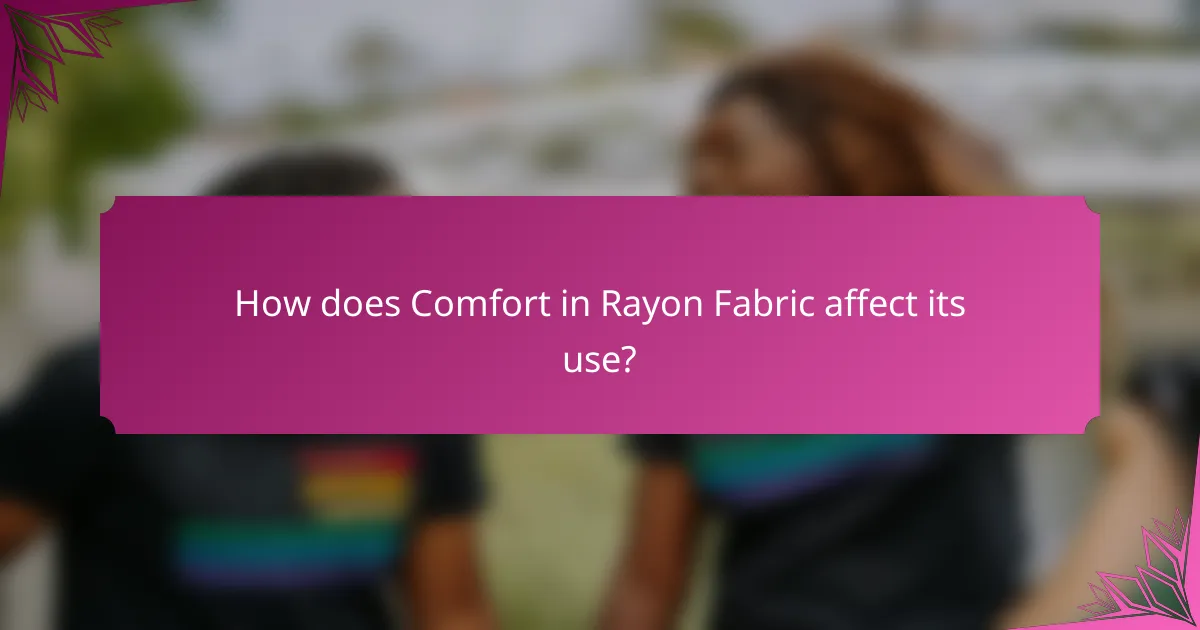
How does Comfort in Rayon Fabric affect its use?
Comfort in rayon fabric significantly enhances its use in clothing and home textiles. Rayon is known for its soft texture and breathability. These properties make it suitable for warm weather attire. The fabric drapes well, which contributes to its appeal in fashion. Additionally, the comfort of rayon encourages longer wear, increasing consumer satisfaction. Studies show that fabrics with higher comfort ratings lead to more frequent use. This is particularly relevant in activewear and loungewear markets. Overall, comfort is a key factor driving the popularity and application of rayon fabric.
What factors contribute to the comfort level of Rayon Fabric?
The comfort level of rayon fabric is influenced by its softness, breathability, and moisture absorption. Rayon is made from natural cellulose fibers, which provide a smooth texture against the skin. This smoothness contributes to a pleasant wearing experience. Additionally, rayon is highly breathable, allowing air circulation that helps regulate body temperature. This feature is crucial for comfort in warm weather. Furthermore, rayon excels in moisture absorption, drawing sweat away from the body. This property keeps the wearer dry and comfortable. Studies show that fabrics with high moisture-wicking capabilities enhance comfort during physical activities. Thus, the combination of softness, breathability, and moisture management makes rayon fabric comfortable to wear.
How does the softness of Rayon Fabric enhance wearer experience?
The softness of rayon fabric significantly enhances the wearer experience by providing exceptional comfort. This softness allows the fabric to drape elegantly on the body, reducing friction against the skin. As a result, wearers enjoy a smooth sensation, which is particularly beneficial in hot weather. Rayon also absorbs moisture effectively, keeping the wearer cool and dry. Studies show that softer fabrics can reduce skin irritation and increase overall satisfaction. The luxurious feel of rayon contributes to a sense of well-being, making it a preferred choice for clothing. Thus, the softness of rayon fabric plays a crucial role in enhancing comfort and satisfaction for the wearer.
What role does breathability play in the comfort of Rayon Fabric?
Breathability significantly enhances the comfort of Rayon fabric. This property allows air circulation, which helps regulate body temperature. As a result, wearers experience less sweating and discomfort. Rayon is known for its moisture-wicking abilities, further contributing to its comfort. Studies show that breathable fabrics improve overall wearability in various climates. The ability to draw moisture away from the skin keeps the wearer feeling dry. Therefore, breathability is a critical factor in the comfort level of Rayon fabric.
In what ways does the drape of Rayon Fabric influence garment design?
The drape of rayon fabric significantly influences garment design by affecting the silhouette and flow of clothing. Rayon has a soft, fluid drape that allows it to fall gracefully over the body. This characteristic enables designers to create garments that enhance movement and comfort. The ability of rayon to mimic the drape of silk makes it suitable for elegant evening wear. Additionally, its lightweight nature contributes to a relaxed fit in casual styles. The drape also impacts layering techniques in design, allowing for versatile styling options. Designers often utilize rayon’s drape to achieve intricate details such as ruffles and pleats. The versatility in drape allows for creative expression in various fashion contexts. Thus, the drape of rayon fabric is a crucial factor in garment design, shaping both aesthetics and functionality.
How does the weight of Rayon Fabric affect its draping capabilities?
The weight of Rayon fabric significantly influences its draping capabilities. Lighter Rayon fabrics tend to drape more fluidly, creating soft, flowing silhouettes. Heavier Rayon fabrics provide more structure and can create sharper lines in garments. The weight affects how the fabric falls and moves with the body. Research indicates that fabrics with a lower weight per square meter exhibit greater flexibility in draping. This flexibility allows for more dynamic movement in designs. Conversely, heavier weights may limit movement but enhance durability. Therefore, the weight of Rayon is a critical factor in determining its overall draping quality.
What styles benefit most from Rayon Fabric’s drape?
Styles that benefit most from Rayon Fabric’s drape include flowing dresses, blouses, and wide-leg trousers. These styles utilize Rayon’s soft texture and fluid movement. The fabric’s ability to create graceful lines enhances the overall silhouette. Additionally, garments like skirts and cardigans also take advantage of Rayon’s drape. This quality allows for a more flattering fit and comfortable wear. Rayon’s lightweight nature contributes to its versatility in various designs. As a result, it is favored for both casual and formal attire.

What are the best practices for using Rayon Fabric?
The best practices for using rayon fabric include proper washing, drying, and storing techniques. Rayon should be washed in cold water to prevent shrinkage. Gentle cycles or hand washing are recommended to maintain fabric integrity. Avoid harsh detergents; use mild soap instead. Rayon should be air-dried to prevent damage from high heat. If necessary, ironing should be done on a low setting while the fabric is slightly damp. Store rayon garments in a cool, dry place, preferably hanging to avoid wrinkles. Following these practices helps prolong the life and appearance of rayon fabric.
How should Rayon Fabric be cared for to maintain its qualities?
Rayon fabric should be hand washed or machine washed on a gentle cycle with cold water. Use a mild detergent to prevent damage. Avoid bleach, as it can weaken the fibers. After washing, air dry the fabric to maintain its shape and prevent shrinkage. If ironing is necessary, use a low heat setting and iron the fabric while it is slightly damp. These care methods help preserve the softness and drape of rayon. Proper care extends the lifespan of rayon garments.
What washing methods are recommended for Rayon Fabric?
Rayon fabric is best washed using gentle methods to preserve its quality. Hand washing in cold water with mild detergent is recommended. Machine washing should be done on a delicate cycle with cold water. Avoid using bleach, as it can damage the fibers. Rayon should be air-dried to prevent shrinkage and maintain shape. Heat from dryers can cause significant damage. Following these methods helps maintain the fabric’s comfort and drape.
How can you prevent damage to Rayon Fabric during storage?
To prevent damage to rayon fabric during storage, keep it in a cool, dry place. High humidity can cause mildew, while heat may weaken the fibers. Use breathable garment bags instead of plastic to allow air circulation. Avoid hanging rayon garments for long periods, as this can stretch the fabric. Instead, fold them neatly to maintain their shape. Store away from direct sunlight to prevent fading. Lastly, ensure the fabric is clean before storage, as stains can set in over time.
What tips can enhance the longevity of Rayon Fabric garments?
To enhance the longevity of Rayon Fabric garments, proper care is essential. Wash Rayon in cold water to prevent shrinkage. Use a gentle detergent that is suitable for delicate fabrics. Avoid bleach, as it can damage the fibers. Air dry the garments instead of using a dryer to maintain their shape. Store Rayon items in a cool, dry place to prevent mildew. Iron Rayon on a low setting, preferably while the fabric is slightly damp. Additionally, avoid prolonged exposure to direct sunlight, which can fade colors. Following these tips can significantly extend the lifespan of Rayon garments.
How can proper ironing techniques improve the appearance of Rayon Fabric?
Proper ironing techniques can significantly enhance the appearance of rayon fabric. Rayon is prone to wrinkles and distortions due to its smooth, delicate fibers. Using the correct heat setting is crucial; a low to medium temperature is recommended to prevent damage. Steam can be beneficial, as it relaxes the fibers and helps remove creases. Ironing rayon while it is slightly damp can also yield better results. This technique prevents the fabric from burning and allows for easier smoothing. Additionally, using a pressing cloth protects the fabric from direct heat. These methods ensure that the rayon maintains its luster and drape, resulting in a polished look.
What are common pitfalls to avoid when using Rayon Fabric?
Common pitfalls to avoid when using rayon fabric include improper washing methods. Rayon is prone to shrinking and losing shape if washed in hot water. Always use cold water and a gentle cycle to preserve the fabric’s integrity. Another pitfall is ignoring drying instructions. Rayon should not be tumble-dried as it can become misshapen. Instead, air drying is recommended to maintain its drape and softness. Additionally, rayon can be susceptible to wrinkles. Avoiding prolonged storage in a crumpled state can help prevent this issue. Finally, using harsh chemicals or bleach can damage rayon fibers. Always opt for mild detergents to ensure the longevity of the fabric.
Rayon fabric is a semi-synthetic textile made from regenerated cellulose fibers, primarily sourced from wood pulp. The article analyzes key aspects of rayon, including its comfort, drape, and environmental considerations associated with its production. It covers the manufacturing process, characteristics such as softness and breathability, and how these factors influence garment design and wearer experience. Additionally, the article addresses the environmental impact of rayon production and suggests sustainable practices to mitigate negative effects, ensuring a comprehensive understanding of rayon fabric’s role in textiles.

